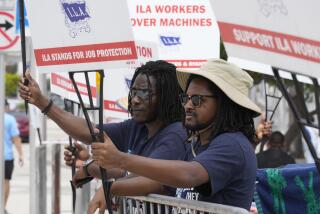UAW Gives Up, Orders Caterpillar Strikers Back : Labor: Directive ends 17-month walkout, letting firm impose its own terms on 9,000 union workers. Their rejection of latest company offer is moot.
- Share via
PEORIA, Ill. — Seventeen months into a labor walkout that has become a dismal and costly failure, the United Auto Workers on Sunday ordered 9,000 workers at Caterpillar Inc. to return to their jobs, even as those strikers over the weekend voted down the company’s latest contract proposal.
The union’s surrender leaves the giant manufacturer of earthmoving equipment free to impose its own terms. The workers have not had a contract since 1991. During two strikes and a long anti-company campaign within the factories, Caterpillar has only become less generous with what it puts on the table.
The strikers voted down the Peoria, Ill.-based corporation’s latest proposal by an overwhelming margin. Some union locals reported heavy votes against the offer: 94% in York, Pa.; 92% in Decatur, Ill. But with the rumor mill causing workers to presume they were on their way back to their machines anyway, the vote merely became a final act of defiance before acknowledging the strike’s collapse.
The UAW leaders would not reveal vote totals.
“The company has a juggernaut here that is really rolling,” said George Erbe, a UAW member in York, the site of one of seven locals on strike in four states. “This has all been just so hard on everyone. It has been your worst nightmare come true. The pain it has caused is unbelievable.”
Many strikers are now angry at the UAW for ending the strike, either too soon or too late--and some vow to continue the fight inside the plants, refusing to speak with any of the 4,000 UAW workers who crossed the picket lines.
“The scabs is what killed us,” said striker Tom Hill. “I ain’t going to talk to them. Fact is, it’ll make me mad just to look at them.”
Most of those 4,000 line crossers have long quit paying union dues and were not permitted to vote on Caterpillar’s new six-year proposal. However, the offer was not popular with them either.
“The longer the union stays without a contract, the worse the company’s offers become,” said line crosser Jim Mangan. “By striking, the union has allowed the company to find out how easy it is to replace union workers. Really, there are so many people tickled to death to do the work.”
During the four-year dispute, Caterpillar consistently has been able to outmaneuver the union. When the UAW first went on strike, the company forced the workers back after five months by threatening to hire permanent replacements.
The union then carried its struggle back into the factories, asking workers to slow things down on the job and to wear anti-Caterpillar buttons and T-shirts. This led to harsh disciplinary measures against union members, which in turn led to nearly 200 charges against the company by the National Labor Relations Board.
These charges allowed the UAW to strike again, this time over unfair labor practices instead of contract issues. Under federal law, the company could not legally hire permanent replacements during this second kind of walkout, so the UAW thought it finally had the company outfoxed.
Instead, Caterpillar attempted something unprecedented for a manufacturer of its size. It kept its factories running at full speed, using managers, office workers and line crossers. With the demand high for its tractors, Caterpillar produced a run of record profits while its largest union stood on the street.
Despite the company’s success, the walkout persisted month after month. By now, most workers have sacrificed nearly two years of Caterpillar wages, about $80,000, though the union has supported them with $300 a week in strike pay.
“You can get by on that,” said striker Terry Smith. “But it’s like being in a raft, trying to avoid the high waves.”
The walkout has been hugely expensive for the UAW too, depleting about $4 million a week in pay and health benefits from its strike fund.
Strikers had hopes that new leadership at the Detroit-based union, elected in June, could negotiate an acceptable settlement. But Caterpillar’s latest proposal, delivered to the union on condition that it be put to a vote, was a severe disappointment to the workers.
“It was an offer made only to punish us,” said Larry Solomon, president of the Decatur local. “It contains everything the company needs to bust the union.”
Besides items long unacceptable to the UAW, such as two-tier wages and a managed-care health plan, the latest offer limited the union grievance procedure and allowed the company to use part-time and temporary workers as up to 15% of the work force.
Caterpillar Vice President Wayne Zimmerman said all striking employees will be allowed to return to work, but it may take days or weeks to sort out who will go where and what will happen to replacement workers.
The strikers were told not to report back to work until they hear from the union later in the week, a union spokesman said.
Times wire services contributed to this story.
(BEGIN TEXT OF INFOBOX / INFOGRAPHIC)
Years of Strife at Caterpillar
Major events in the dispute between Caterpillar Inc. and the United Auto Workers:
* Sept. 30, 1991: Three-year contract expires.
* Nov. 4: Union begins limited strike, expanding it gradually.
* April 1, 1992: Caterpillar says it will impose terms of its final offer, vows to replace strikers.
* June 2: Caterpillar and UAW meet with federal mediator, then end negotiations.
* April 14: UAW agrees to return to work; negotiations to continue.
* June 28, 1993: Administrative judge begins hearings on unfair labor practice complaints filed against Caterpillar.
* May 7, 1994: UAW proposes “baseball-style arbitration” to resolve dispute, the first new proposal in nearly two years; Caterpillar refuses.
* May 13: Caterpillar offers to negotiate if UAW agrees to let members vote on whatever proposal is on the table after 30 days; UAW refuses.
* June 20: Caterpillar-UAW meet for first time in two years. Talks collapse.
* June 21: UAW begins companywide strike.
* Jan. 19, 1995: Caterpillar announces record profits of $955 million.
* Feb. 3: Four-day talks end with Caterpillar complaining that UAW would not offer a comprehensive, “forward-looking” proposal.
* Feb. 24: Caterpillar announces Chairman Donald V. Fites made $1.8 million for 1994, a 10% increase.
* Aug. 29-31: Caterpillar, UAW negotiate; meetings cut short after someone fires rifle at homes of two company employees.
* Sept. 28: Full bargaining teams meet, but both sides switch to strategy of small, high-level discussions.
* Nov. 28: Caterpillar gives UAW a new contract offer; UAW agrees to let members vote.
* Dec. 2-3: UAW members reject offer, but the central bargaining committee votes to end strike.
Source: Associated Press
More to Read
Inside the business of entertainment
The Wide Shot brings you news, analysis and insights on everything from streaming wars to production — and what it all means for the future.
You may occasionally receive promotional content from the Los Angeles Times.










